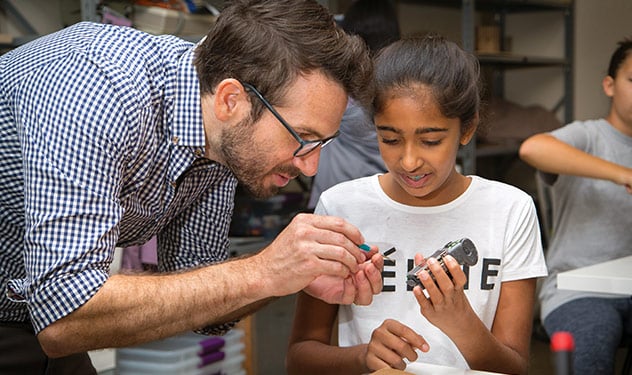
Middle school is a time of transition. Transitioning between schools, transitioning between social circles, transitioning physically and socially from children into teenagers. And like a lot of transitions, things can get a little challenging from time to time, especially when children are left to navigate the many complexities of middle school on their own.
But middle school shouldn’t be a struggle! With the right support, middle school can become a time of self-discovery and personal growth that lays the foundation for success, both now and in high school and beyond.
Explore what it is like to be a member of the Friends' Central Middle School community.
That’s why having a strong middle school advisory program is so important.
What is a Middle School Advisory Program?
At most public schools and even a lot of private or independent schools, student support typically takes the form of a guidance counselor who oversees a group of students. A large part of the job, for guidance counselors, is helping students choose the right coursework and preparing for their next steps academically. They might also be called into action to help a student work through a personal or academic crisis.
And while guidance counselors have an important role to play in the education system, they often simply can’t offer the one-on-one support necessary to truly help a student thrive. Though the American School Counselor Association recommends a student-to-counselor ratio of 250:1, the average ratio in the U.S. is closer to a whopping 491:1.
Advisory programs, on the other hand, are designed to create a strong support system that students need to develop academically, socially, and emotionally.
As opposed to a being called upon in response to a crisis, as might be the case with a guidance counselor, advisory programs are meant to be proactive, creating a strong support system and safety net that students can turn to before something becomes a crisis.
Though the specifics of each advisory program will vary from school to school, their primary purpose is to make sure that each student has an adult who can act as their advocate, which is often achieved through a mix of one-on-one and group guidance.
At Friends’ Central, for example, each advisor has a group of about eight to ten students who meet with them a minimum of twice a day: During homeroom at the start of the school day, and during an advisory period just before the end of the day. These advisory periods perform a number of important functions, including:
- Allowing students to prepare for the school day ahead of them (in the morning) and to get a head start on homework or assignments (in the afternoon)
- Giving students the opportunity to seek out help from teachers in classes or assignments
- Creating a sense of community and ensuring students know that there is always someone that they can turn to for help, whether academically, socially, or personally
- Creating a strong support system for each student by supplying a single point-person (their advisor) who will develop a strong relationship with them and their parents
And all of that personal attention really pays off - there are a lot of benefits associated with strong middle school advisory programs.
Benefits of a Strong Middle School Advisory Program
1. Supports strong academics
Advisory programs are important because they give students time that is specifically designed to help them succeed academically. Exactly how the time is used depends on the specifics of the school, but it is often used to do things like:
- Prepare and plan for the day ahead
- Get a head start on homework or other assignments, or study before leaving for the day
- Speak with teachers about classes or subjects that they are struggling with (especially important for students who might not be comfortable speaking up and asking questions in class)
Beyond simply supporting strong academics, this also helps students develop important skills that will help them succeed throughout the rest of their lives: time management, the ability to plan ahead, self-advocacy, and the ability to ask for help when it is needed.
2. Helps students navigate the social and emotional issues unique to middle school
Advisory programs don’t just act as “study halls.” They play an important role in the social and emotional health of students.
Middle school can be a tricky time for students, both emotionally and socially, as they begin to create their own identity separate from their parents, siblings, and friends. It’s a time of self-discovery and a time for pushing boundaries, and it’s not uncommon for students to struggle with all of those changes and the challenges that come with them.
By ensuring that each student has an adult that they are comfortable talking with about these things, a strong advisory program can help students work through common middle school issues like:
- Shifting friendships
- Conflict resolution
- Appropriately expressing emotions
- Deaths in the family
- Changes in the family, such as divorce
- And much more
The key to success is making sure that the student understands that they can always talk to someone about anything that is bothering them, and that adults are ready to offer support and guidance.
3. Create a positive school culture
By helping students work through social and emotional problems as they arise, advisory programs naturally help to create a positive and connected school culture.
They do this directly by reminding students that they are a part of a community of parents, teachers, administrators, and friends that wants them to succeed, be happy, and be healthy. When students feel validated, understood, and accepted, they naturally develop stewardship for themselves and others.
And they do this indirectly by helping to reduce the stress—whether academic or emotional—that can lead to problems in the first place.
4. Creates a proactive safety net and support structure
For an advisory program to be successful, it’s important that students and advisors form real, strong, and lasting relationships with one another.
By doing so, they can facilitate a level of mutual trust that allows for deep and meaningful communication. Once that open channel for communication exists between students and their advisors, we find that students naturally will seek advice and help when they need it. And advisors, for their part, gain insight into their students that helps them recognize when there are problems that might need to be addressed.
All of this helps to create a proactive safety net and support structure designed to identify issues before they turn into crises.
5. Facilitates easier communication
By creating a single point-person for each student, advisory programs make communication—at all levels—easier and more intuitive for everyone involved.
For example, a teacher who sees a particular student struggling, or notices an issue developing, can speak to the student’s advisor. The advisor can then leverage their relationship with the student to figure out what is going on or determine whether the student is showing difficulties extending into multiple classes (and not just that single class) which may speak to a larger problem.
Or, parents might inform their child’s advisor that there is a challenging situation going on at home that the school should be aware of, and the advisor can then notify the relevant teachers and faculty members so that everyone is aware.
And, of course, because of their relationship with their advisor, students often feel more comfortable speaking with them about delicate issues that they perhaps don’t feel comfortable speaking with their other teachers or even their parents about. The advisor can then use their position to facilitate communication between whoever should be involved.
All of this leads to a more informed and engaged community striving to help students reach their fullest potential.
The Importance of Relationships
In the end, what makes advisory programs so powerful are the relationships that they help to foster between students and faculty.
These relationships allow for free and open communication, letting students know they can ask for help, and giving advisors insight into the struggles that students are facing. These relationships are what truly support academic success and excellence.



